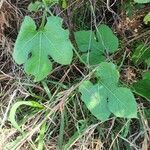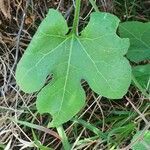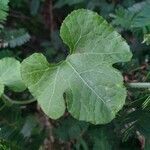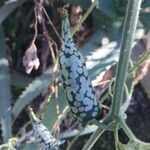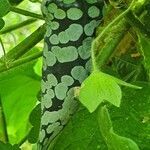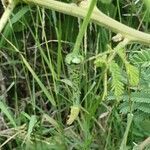Perennial herb. Prostrate or scandent to 2 m or more, from tuberous rootstock; stems shortly and finely spreading-hispid or minutely setulose. Leaf-lamina 2·8-7·5 x 4-11 cm, broadly ovate to pentagonal in outline, cordate, ± sinuate-denticulate, densely and finely pubescent to hispid-setulose especially on veins beneath, shortly and finely rather densely pubescent or hispid above, becoming ± scabrid with age, unlobed or incipiently to deeply palmately 3-5(7)-lobed; lobes ovate-triangular to elliptic, obovate or obovate-lanceolate, the central largest, broadly rounded to obtuse, apiculate or long-apiculate. Petioles 1·8-6 cm long, finely hispid or pubescent, also spreading-setulose on upper margins. Tendrils 2-fid, rarely simple. Flowers monoecious, male and female usually at different nodes. Male flowers c. 5-11 in pedunculate axillary racemes; peduncles 0·8-5·5 cm long; pedicels 1-8 mm long, distinctly but minutely bracteate. Receptacle-tube 2·2-3 mm long; lobes 4-9 mm long, narrowly triangular to lanceolate, acute, attenuate, long-acuminate. Petals 3·5-5 mm long, yellow or greenish-yellow. Female flowers solitary, axillary; pedicel 1-4 mm. long; ovary 10·5-18 x 1·5-2 mm, cylindrical, shortly pubescent; receptacle-tube 1·5-2·5 mm long, lobes 4-4·5 mm long, lanceolate-subulate, acute; petals 6-8 mm long. Fruit 5·8-6·5 x 1·6-2·3 cm, cylindric-fusiform, rounded at the base, rostrate, green spotted pale green or white, becoming red and splitting longitudinally when ripe; pedicel 0·2-1·2 cm long, stout. Seeds 4·8-5 x 3·8-4 x 3·2-3·5 mm, subglobose, smooth, bordered.
Perennial herb. Scandent to 1 m, from tuberous rootstock; stems minutely rather sparsely crispate-pubescent or shortly setulose. Leaf-lamina 1.7-5.4 x 3.0-7.8 cm, broadly ovate to suborbicular in outline, cordate, sinuate-denticulate, densely rather finely shortly hispid beneath and somewhat less densely so above, unlobed to deeply palmately 3-5-lobed, lobes ovate to broadly elliptic, obtuse to broadly rounded, apiculate, the central largest, sometimes 3-lobulate. Petioles 0.7-3.1 cm long, shortly finely pubescent or hispid, also ascending-setulose especially on upper margins. Tendrils simple, rarely 2-fid. Flowers monoecious, male and female at different nodes. Male flowers 5-20 in pedunculate axillary racemes; peduncles 1.5-9.2 cm. long; pedicels 1.5-5 mm long. Receptacle-tube 1.8-3 mm long, campanulate; lobes 0·8-1·3 mm long, triangular, acute. Petals 2-2.5 mm long, cream, yellow or greenish-yellow. Female flowers solitary, axillary; pedicel 11-15 mm long; ovary 14-16 x 1-2 mm, cylindrical, glabrous; receptacle-tube 2 mm long, lobes 1 mm long; petals 2·5 mm long. Fruit 4.5-6.5 x 1.5-1.6 cm, fusiform, tapered towards the base and apex, long-rostrate, green, becoming red and splitting longitudinally when ripe; pedicel 0.5-1.5 cm long, rather slender. Seeds 4.5-5 x 3.4-3.8 x 3.1-3.5 mm, subglobose, smooth or slightly rugose, bordered.
Monoecious, perennial herb, rootstock tuberous up to 200 mm long. Stems prostrate or climbing, up to 2 m long, ± hairy. Leaves densely and finely hairy, more on veins below, later ± scabrid, outline ovate to pentagonal, cordate, up to 75-110 mm long, ± sinuate-denticulate, unlobed to deeply palmately 3-7-lobed; lobes ± triangular to ± lanceolate, central largest; petioles 18-60 mm long, hairy. Male flowers ± 5-11 in pedunculate, axillary racemes; peduncles 8-55 mm long; pedicels 1-8 mm long; receptacle tube 1-3 mm long; lobes ± lanceolate, 4-9 mm long; petals 3.5-5.0 mm long, ± yellow. Female flowers solitary, axillary; pedicel 1-4 mm long; receptacle tube 1.5-2.5 mm long; lobes ± lanceolate, 4.0-4.5 mm long; petals 6-8 mm long. Flowering time Oct.-Feb. Fruit cylindric-fusiform, base rounded, rostrate, up to 65 x 23 mm, green spotted, pale green or white, ripening red, splitting lengthwise; pedicel 2-12 mm long, stout. Seeds subglobose, ± 5 mm long, smooth, bordered.
A herb. It is a pumpkin family plant. It can grow each year from seeds or keep growing from year to year. It is 1 m long. It is a climber. It has a taproot and puts up annual stems. It has simple tendrils. The leaves are simple with 5 shallow lobes. The leaves are 6 cm long by 10 cm across. The lobes widen at the tip. The male and female flowers are separate on the same plant. They are small and greenish-yellow. The male flowers are on a hanging stalk and the female flowers on a short stalk. The fruit are green and turn orange as they ripen. They are oblong.
Prostrate or scandent herb. Tendrils bifid, rarely simple. Male peduncles stout, distinct from pedicels which are much more slender. Receptacle lobes of male flowers 4-9 mm long, narrowly triangular to lanceolate, of female flowers 4.0-4.5 mm long. Fruit glabrous, 58-65 mm long, cylindric-fusiform, rounded at base, rostrate, green mottled pale green or white when immature, becoming red when ripe. Seeds subglobose. Flowers yellow or greenish yellow.
Scandent herb. Tendrils simple, rarely bifid. Male peduncles stout, distinct from pedicels which are much more slender. Receptacle lobes of male flowers 0.8-1.3 mm long, triangular, of female flowers 1 mm long. Fruit glabrous, 45-65 mm long, fusiform, attenuate at base, long rostrate, uniformly green when immature, becoming red when ripe. Seeds subglobose. Flowers cream, yellow or greenish yellow.
Leaf-lamina 1·7–5·4 × 3·0–7·8 cm., broadly ovate to suborbicular in outline, cordate, sinuate-denticulate, densely rather finely shortly hispid beneath and somewhat less densely so above, unlobed to deeply palmately 3–5-lobed, lobes ovate to broadly elliptic, obtuse to broadly rounded, apiculate, the central largest, sometimes 3-lobulate.
male flowers 5–20 in pedunculate axillary racemes; peduncles 1·5–9·2 cm. long; pedicels 1·5–5 mm. long. Receptacle-tube 1·8–3 mm. long, campanulate; lobes 0·8–1·3 mm. long, triangular, acute. Petals 2–2·5 mm. long, cream, yellow or greenish-yellow.
Fruit 4·5–6·5 × 1·5–1·6 cm., fusiform, tapered towards the base and apex, long-rostrate, green, becoming red and splitting longitudinally when ripe; pedicel 0·5–1·5 cm. long, rather slender.
Female flowers solitary, axillary; pedicel 11–15 mm. long; ovary 14–16 × 1–2 mm., cylindrical, glabrous; receptacle-tube 2 mm. long, lobes 1 mm long; petals 2·5 mm. long.
Petioles 0·7–3·1 cm. long, shortly finely pubescent or hispid, also ascending-setulose especially on upper margins.
Scandent to 1 m., from tuberous rootstock; stems minutely rather sparsely crispate-pubescent or shortly setulose.
Seeds 4·5–5 × 3·4–3·8 × 3·1–3·5 mm., subglobose, smooth or slightly rugose, bordered.
Flowers monoecious, male and female at different nodes.
Tendrils simple, rarely 2-fid.
